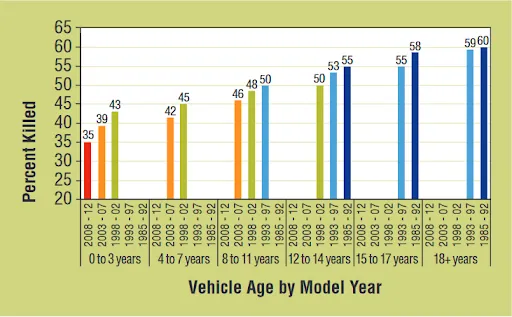
With so many different people on the road, you frequently come across drivers with older vehicles.
You may even own an older car simply because it’s reliable, unique, or cheap.
Some assume that older cars are much safer than newer cars because they have a strong body or don’t drive as fast.
But are older cars safer than newer cars?
To answer this question, we’ve gathered data from multiple reputable sources to see if the age of a car makes any difference when it comes to safety during auto accidents.
Modern cars are safer than unmodified classic cars due to advancements in safety technology. Features such as seat belts, airbags, and crash avoidance systems significantly reduce fatalities and injuries in accidents, as confirmed by the National Highway Traffic Safety Administration (NHTSA).
General Facts About Car Ownership in the US and California
It should come as no surprise that California and the United States as a whole is car-centric.
According to the California Department of Motor Vehicles, there were more than 35.8 million vehicles registered in the state in 2020.
Out of all jurisdictions in California, Los Angeles County had the highest number of registrations, topping out at about 7.9 million or 22% of the state total.
Another study by the Bureau of Transportation Statistics (BTS) also found that the average age of vehicles on the road was 11.9 years in 2020. In contrast, the average back in 1995 was 8.4 years.
Old Car vs. New Car Crash Statistics
Generally speaking, as the age of vehicles on the road continues to increase, so does the number of serious accidents.
In fact, a 2021 citywide report from the Los Angeles Police Department found that crashes involving an injury increased by 14% from 2019 to 2021. For auto accident deaths, the increase was even greater at around 20%.
While this may seem like a simple correlation, consider the following report from the National Highway Traffic Safety Administration (NHTSA).
In 1997, the occupancy fatality rate in the US was 17.81 per 100,000 registered vehicles. By 2017, this number dropped by nearly 44%.
According to the NHTSA, this drop is likely due to the new safety features that began appearing in new vehicles.
They even found that the average vehicle on the road in 2012 had a 56% lower fatality risk than the average vehicle in the 1950s.
Most of this research comes from a study they conducted in 2013. Some of the most compelling data comes from this study, and it suggests that newer is almost always better.
For this study, the NHTSA examined 251,826 drivers involved in an accident between 2005 and 2011—47% of them died in their accident while 53% survived.
In this sample group of accidents, vehicles which were 0-3 years old had the lowest fatality rate, at about 35%. However, vehicles 18+ years old had the highest fatality rate, ranging from 59-60%.

So are older cars safer than newer cars? Contrary to popular belief, no.
In fact, they are more dangerous than newer models due to the lack of modern safety features. This puts many drivers on the road at risk of serious injury or death if they have an accident.
The Equipment That Makes New Cars Safer
One of the main reasons that new cars are safer than old cars is because of the new safety technology developed by manufacturers.
While these systems aren’t perfect, they greatly reduce the risk of death when the driver gets into an accident. Some of these features aren’t available on older vehicles, thus presenting a huge risk to drivers and passengers.
Seat Belts
One of the first and oldest innovations in vehicle safety technology is the three-point seat belt system.
This restraint prevents occupants from flying out the windshield or other windows during severe impacts, saving hundreds of thousands of lives over the past few decades.
It’s so effective that only 26% of restrained drivers in brand new cars die in a serious collision, compared to 72% of unrestrained drivers.
Air Bags
Another old but constantly evolving safety feature in vehicles is the airbag.
First introduced nearly 70 years ago, the airbag helps prevent occupants from hitting their head on hard components of the car, such as the dashboard or steering wheel.
While older models typically have only front airbags, new cars have airbags on the side as well, increasing safety during collisions.
Backup Cameras
A relatively new technology included in vehicles today is the backup camera. The aim of this system is to help drivers back up safely without hitting pedestrians or other vehicles.
At the time of the NHTSA’s studies on vehicle age, backup cameras weren’t standard on most cars.
However, the NHTSA now requires backup cameras on all new vehicles made after 2018.
Stability Control
One common problem that older vehicles have is spinning out, especially in adverse road conditions. To help prevent this, many newer vehicles come equipped with electronic stability control.
This system uses the car’s computer to automatically brake in a way that helps the driver maintain control of the vehicle.
As of September 1, 2011, the NHTSA requires all new consumer vehicles to have this electronic stability control system.
Injured in an Accident? Contact Us for a Free Consultation
When asking, Are old cars safer than new cars? it’s easy to forget that accidents can happen at any moment.
Even if you have a newer model vehicle, there are other factors that go into the severity of your crash.
If you sustain an injury in an accident due to a negligent driver, make sure to contact Weinberg Law Offices.
From day one, we fight tirelessly for the compensation you need for your recovery. While other attorneys may pass your case between legal assistants, we work with clients one-on-one every step of the way.
To us, communication and reputation are essential, so we always keep our clients informed and aren’t afraid to go to trial if necessary.
To schedule a free consultation, please send us a message or call us at 818-697-1079. We proudly serve clients throughout California from our practice in Los Angeles.
Disclaimer: This content should not be construed as legal advice.
